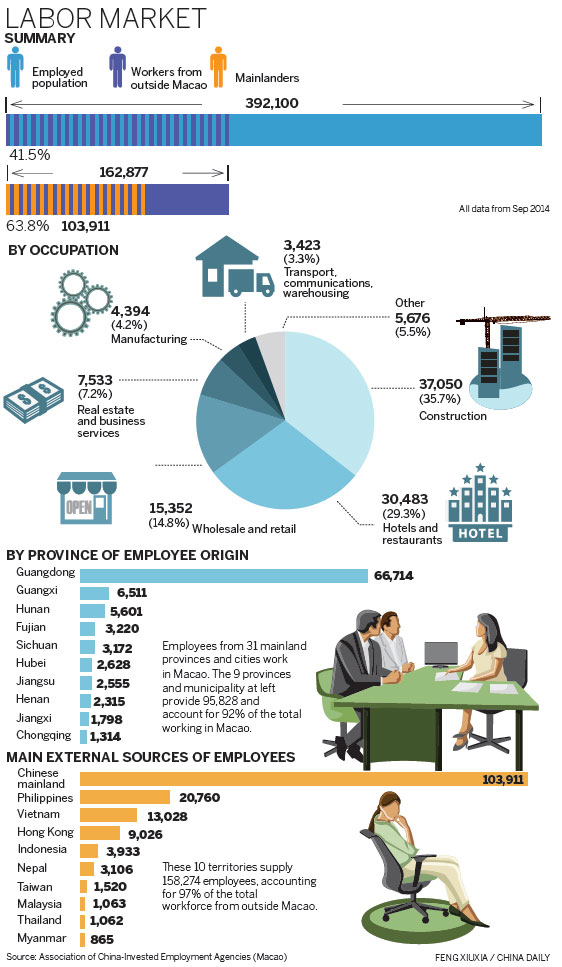Nearly two-thirds of imported laborers in SAR are from mainland
Yan Zhibiao arrived at Gongbei Port before 7 am to join a long winding line where thousands jostled each other in a crowd half the size of a football field.
It was an hour after the 44-year-old had kissed his 3-year-old daughter goodbye and begun the daily commute to cross the border.
Shivering in the early December dawn as he goes through customs checks, Yan is one of nearly 104,000 mainland laborers working in the Macao Special Administrative Region.
A lighting engineer in the Galaxy Entertainment Group resort and gambling house, Yan has spent at least 40 minutes every day for the last four years at Gongbei Port in Zhuhai, Guangdong province.
His command of English has assured him a job with decent pay of around 40,000 Macao pataca ($5,012) a month, though daily border crossings have been tough.
"I was invited to Gongbei Port to see a video of the pushing and squeezing at peak hours. It was shocking that many of them literally had to fight their way out just to be on time for work," said Liao Jiancheng, director-general of the Association of China-Invested Employment Agencies (Macao), a self-regulatory organization of 18 mainland employment agencies that serves more than 11,000 enterprises in Macao.
Mainland workers, who have brought "new blood" into Macao to retain the balance of the local labor market, "deserve the dignity to work and travel as a decent member of society", he added.
The world's largest gambling hub by revenue, Macao surpassed Singapore last year to become the second-largest destination of Chinese mainland labor, and growth is continuing. So far, 20,000 more mainland migrant workers have obtained work visas in 2014, in what could be another record high.
While experiencing rapid economic growth of 11.9 percent, the city, with a base population of merely 566,500, is facing a severe labor shortage.
Macao's seasonal unemployment rate remained at a historical low of 1.7 percent for August-October. Nearly 64 percent of the total imported laborers in the open economy are mainlanders, who accounted for more than 26 percent of the current working population, up from 8.7 percent in 2004.
Construction is the largest sector where mainland workers have a presence, followed by the hotel and retail industries.
"Young locals won't enter this line of work because it involves strong, physical labor," said Zhang Haitian, construction site supervisor at Omas Construction & Engineering Co. "Sometimes they have to install rebars or operate a tower crane at a height of 160 meters."
Many come to Macao for much better pay than for similar work on the mainland.
Macao's GDP per capita of $91,376 ranks fourth in the world, and is about 13 times more than the Chinese mainland's $6,807, according to World Bank figures.
Like Yan and more than half of the mainland workers, 42-year-old sanitation worker Luo Huanyong moved to Zhuhai for lower rent and commutes daily to work.
Luo, from Meizhou, Guangdong province, makes 4,300 pataca per month.
Despite the pressure brought by rising rents and inflation in Macao, Liao said mainland workers can still make an average of 50,000 pataca a year, which is "higher than that in central of western regions of the mainland".

